Effects of Soundscape Complexity on Urban Noise Annoyance Ratings: A Large-Scale Online Listening Experiment
Abstract
1. Introduction
2. Materials and Methods
2.1. Platform and Participants
2.2. Auditory Stimuli
2.3. Experimental Procedure
2.3.1. Browser Sound Check and Volume Calibration
2.3.2. Huggins Pitch Test (HP)
2.3.3. Active Listening Tasks
3. Data Analysis
4. Results
4.1. Noise Annoyance as a Function of Sound Sources Combinations (Research Question #1)
4.2. Noise Annoyance as a Function of Soundscape Complexity (Research Question #2)
4.3. Noise Annoyance as a Function of Individual Sound SOURCES presence (Research Question #3)
5. Discussion
5.1. Effect of Sound Sources Combinations (Research Question #1)
5.2. Effect of Number of Sound Sources, or “Soundscape Complexity” (Research Question #2)
5.3. Effect of Specific Sound Sources (Research Question #3)
6. Conclusions
- Combinations of sound sources in soundscape recordings is less important than the actual number of sound sources identified in the acoustic environment (which in this study we defined as “soundscape complexity”).
- A combination of any two clearly distinguishable sound sources (low soundscape complexity) in a given urban soundscape appears to minimize the perceived noise annoyance, which is higher instead, when the number of sources either increases or decreases.
- The presence of sound sources related to road traffic in a soundscape is associated with higher noise annoyance, while the presence of natural sound sources is associated with lower noise annoyance (even when road traffic noise is present).
Author Contributions
Funding
Institutional Review Board Statement
Informed Consent Statement
Data Availability Statement
Acknowledgments
Conflicts of Interest
References
- World Health Organization. Burden of Disease from Environmental Noise; WHO Regional Office for Europe: Copenhagen, Denmark, 2011. [Google Scholar]
- Li, A.; Martino, E.; Mansour, A.; Bentley, R. Environmental Noise Exposure and Mental Health: Evidence From a Population-Based Longitudinal Study. Am. J. Prev. Med. 2022, 63, e39–e48. [Google Scholar] [CrossRef] [PubMed]
- European Environment Agency. Environmental Noise in Europe—2020; Publications Office of the European Union: Luxembourg, 2020. [CrossRef]
- World Health Organization. Environmental Noise Guidelines for the European Region; WHO Regional Office for Europe: Copenhagen, Denmark, 2018. [Google Scholar]
- Miedema, H.M.; Vos, H. Exposure-response relationships for transportation noise. J. Acoust. Soc. Am. 1998, 104, 3432–3445. [Google Scholar] [CrossRef] [PubMed]
- Guski, R.; Felscher-Suhr, R.; Schuemer, R. The concept of noise annoyance: How international experts see it. J. Sound Vib. 1999, 223, 513–527. [Google Scholar] [CrossRef]
- Klein, A.; Marquis-Favre, C.; Weber, R.; Trollé, A. Spectral and modulation indices for annoyance-relevant features of urban road single-vehicle pass-by noises. J. Acoust. Soc. Am. 2015, 137, 1238–1250. [Google Scholar] [CrossRef]
- Torija, A.J.; Ruiz, D.P.; De Coensel, B.; Botteldooren, D.; Berglund, B.; Ramos-Ridao, Á. Relationship between road and railway noise annoyance and overall indoor sound exposure. Transp. Res. Part D Transp. Environ. 2011, 16, 15–22. [Google Scholar] [CrossRef]
- Bangjun, Z.; Lili, S.; Guoqing, D. The influence of the visibility of the source on the subjective annoyance due to its noise. Appl. Acoust. 2003, 64, 1205–1215. [Google Scholar] [CrossRef]
- Aletta, F.; Masullo, M.; Maffei, L.; Kang, J. The effect of vision on the perception of the noise produced by a chiller in a common living environment. Noise Control Eng. J. 2016, 64, 363–378. [Google Scholar] [CrossRef]
- Szychowska, M.; Hafke-Dys, H.; Preis, A.; Kociński, J.; Kleka, P. The influence of audio-visual interactions on the annoyance ratings for wind turbines. Appl. Acoust. 2018, 129, 190–203. [Google Scholar] [CrossRef]
- Berkers, E.; Pop, I.; Cloïn, M.; Eugster, A.; van Oers, H. The relative effects of self-reported noise and odour annoyance on psychological distress: Different effects across sociodemographic groups? PLoS ONE 2021, 16, e0258102. [Google Scholar] [CrossRef]
- Lindborg, P.M.; Friberg, A. Personality Traits Bias the Perceived Quality of Sonic Environments. Appl. Sci. 2016, 6, 405. [Google Scholar] [CrossRef]
- Erfanian, M.; Mitchell, A.; Aletta, F.; Kang, J. Psychological well-being and demographic factors can mediate soundscape pleasantness and eventfulness: A large sample study. J. Environ. Psychol. 2021, 77, 101660. [Google Scholar] [CrossRef]
- ISO/TS 15666:2021; Acoustics—Assessment of Noise Annoyance by Means of Social and Socio-Acoustic Surveys. International Organization for Standardization: Geneva, Switzerland, 2021.
- ISO 12913-1:2014; Acoustics—Soundscape—Part 1: Definition and Conceptual Framework. ISO: Geneva, Switzerland, 2014.
- Rychtáriková, M.; Vermeir, G. Soundscape categorization on the basis of objective acoustical parameters. Appl. Acoust. 2013, 74, 240–247. [Google Scholar] [CrossRef]
- Miedema, H.M. Relationship between exposure to multiple noise sources and noise annoyance. J. Acoust. Soc. Am. 2004, 116, 949–957. [Google Scholar] [CrossRef] [PubMed]
- Aletta, F.; Axelsson, Ö.; Kang, J. Dimensions Underlying the Perceived Similarity of Acoustic Environments. Front. Psychol. 2017, 8, 1162. [Google Scholar] [CrossRef] [PubMed]
- Chau, C.K.; Leung, T.M.; Xu, J.M.; Tang, S.K. Modelling noise annoyance responses to combined sound sources and views of sea, road traffic, and mountain greenery. J. Acoust. Soc. Am. 2018, 144, 3503–3513. [Google Scholar] [CrossRef]
- Orga, F.; Mitchell, A.; Freixes, M.; Aletta, F.; Alsina-Pagès, R.M.; Foraster, M. Multilevel Annoyance Modelling of Short Environmental Sound Recordings. Sustainability 2021, 13, 5779. [Google Scholar] [CrossRef]
- Salamon, J.; Jacoby, C.; Bello, J.P. A Dataset and Taxonomy for Urban Sound Research. In Proceedings of the 22nd ACM International Conference on Multimedia; Association for Computing Machinery: New York, NY, USA, 2014; pp. 1041–1044. [Google Scholar] [CrossRef]
- Tan, J.K.A.; Hasegawa, Y.; Lau, S.K. A comprehensive environmental sound categorization scheme of an urban city. Appl. Acoust. 2022, 199, 109018. [Google Scholar] [CrossRef]
- Kachlicka, M. Mapping Acoustic and Semantic Dimensions of Auditory Perception. Master’s Dissertation, UCL (University College London), London, UK, 2021. [Google Scholar]
- Steele, D.; Bild, E.; Guastavino, C. Moving past the sound-noise dichotomy: How professionals of the built environment approach the sonic dimension. Cities 2023, 132, 103974. [Google Scholar] [CrossRef]
- Bild, E.; Coler, M.; Pfeffer, K.; Bertolini, L. Considering sound in planning and designing public spaces: A review of theory and applications and a proposed framework for integrating research and practice. J. Plan. Lit. 2016, 31, 419–434. [Google Scholar] [CrossRef]
- Kang, J. From dBA to soundscape indices: Managing our sound environment. Front. Eng. Manag. 2017, 4, 184–192. [Google Scholar] [CrossRef]
- Kang, J.; Aletta, F.; Gjestland, T.T.; Brown, L.A.; Botteldooren, D.; Schulte-Fortkamp, B.; Lercher, P.; van Kamp, I.; Genuit, K.; Fiebig, A.; et al. Ten questions on the soundscapes of the built environment. Build. Environ. 2016, 108, 284–294. [Google Scholar] [CrossRef]
- Mitchell, A.; Oberman, T.; Aletta, F.; Erfanian, M.; Kachlicka, M.; Lionello, M.; Kang, J. The International Soundscape Database: An Integrated Multimedia Database of Urban Soundscape Surveys—Questionnaires with Acoustical and Contextual Information. 2021. Available online: https://zenodo.org/record/6331810 (accessed on 21 September 2022).
- Anwyl-Irvine, A.; Dalmaijer, E.S.; Hodges, N.; Evershed, J.K. Realistic precision and accuracy of online experiment platforms, web browsers, and devices. Behav. Res. Methods 2021, 53, 1407–1425. [Google Scholar] [CrossRef] [PubMed]
- Age-Related Hearing Loss. Available online: https://www.nidcd.nih.gov/health/age-related-hearing-loss (accessed on 21 September 2022).
- Peng, Z.E.; Buss, E.; Shen, Y.; Bharadwaj, H.; Stecker, G.C.; Beim, J.A.; Bosen, A.K.; Braza, M.; Diedesch, A.C.; Dorey, C.M.; et al. Remote testing for psychological and physiological acoustics. J. Acoust. Soc. Am. 2022, 151, 3116–3128. [Google Scholar] [CrossRef]
- Mitchell, A.; Oberman, T.; Aletta, F.; Erfanian, M.; Kachlicka, M.; Lionello, M.; Kang, J. The Soundscape Indices (SSID) Protocol: A Method for Urban Soundscape Surveys—Questionnaires with Acoustical and Contextual Information. Appl. Sci. 2020, 10, 2397. [Google Scholar] [CrossRef]
- Mitchell, A.; Oberman, T.; Aletta, F.; Kachlicka, M.; Lionello, M.; Erfanian, M.; Kang, J. Investigating urban soundscapes of the COVID-19 lockdown: A predictive soundscape modeling approach. J. Acoust. Soc. Am. 2021, 150, 4474–4488. [Google Scholar] [CrossRef] [PubMed]
- James Robert, Pydub. GitHub Repository. 2011. Available online: https://github.com/jiaaro/pydub (accessed on 21 September 2022).
- Milne, A.E.; Bianco, R.; Poole, K.C.; Zhao, S.; Oxenham, A.J.; Billig, A.J.; Chait, M. An online headphone screening test based on dichotic pitch. Behav. Res. Methods 2021, 53, 1551–1562. [Google Scholar] [CrossRef]
- Mitchell, A.; Erfanian, M.; Soelitsyo, C.; Oberman, T.; Aletta, F. DeLTA (Deep Learning Techniques for Noise Annoyance Detection) Dataset (1.0) [Data Set]. Zenodo. 2022. Available online: https://zenodo.org/record/7158057 (accessed on 7 October 2022).
- Pandit, S.; Gupta, S. A comparative study on distance measuring approaches for clustering. Int. J. Res. Comput. Sci. 2011, 2, 29–31. [Google Scholar] [CrossRef]
- Agrawal, R.; Srikant, R. Fast algorithms for mining association rules. In Proceedings of the 20th International Conference on Very Large Data Bases, VLDB, Santiago de Chile, Chile, 12–15 September 1994; Volume 1215, pp. 487–499. [Google Scholar]
- Okokon, E.O.; Turunen, A.W.; Ung-Lanki, S.; Vartiainen, A.K.; Tiittanen, P.; Lanki, T. Road-traffic noise: Annoyance, risk perception, and noise sensitivity in the Finnish adult population. Int. J. Environ. Res. Public Health 2015, 12, 5712–5734. [Google Scholar] [CrossRef]
- Kroesen, M.; Molin, E.J.; van Wee, B. Testing a theory of aircraft noise annoyance: A structural equation analysis. J. Acoust. Soc. Am. 2008, 123, 4250–4260. [Google Scholar] [CrossRef]
- Tristán-Hernández, E.; Pavón García, I.; López Navarro, J.M.; Campos-Cantón, I.; Kolosovas-Machuca, E.S. Evaluation of psychoacoustic annoyance and perception of noise annoyance inside University facilities. Int. J. Acoust. Vib. 2018, 23, 3–8. [Google Scholar]
- Schreckenberg, D.; Griefahn, B.; Meis, M. The associations between noise sensitivity, reported physical and mental health, perceived environmental quality, and noise annoyance. Noise Health 2010, 12, 7. [Google Scholar] [CrossRef] [PubMed]
- Cox, T.J. The effect of visual stimuli on the horribleness of awful sounds. Appl. Acoust. 2008, 69, 691–703. [Google Scholar] [CrossRef]
- Öhrström, E.; Barregård, L.; Andersson, E.; Skånberg, A.; Svensson, H.; Ängerheim, P. Annoyance due to single and combined sound exposure from railway and road traffic. J. Acoust. Soc. Am. 2007, 122, 2642–2652. [Google Scholar] [CrossRef] [PubMed]
- Lee, S.C.; Hong, J.Y.; Jeon, J.Y. Effects of acoustic characteristics of combined construction noise on annoyance. Build. Environ. 2015, 92, 657–667. [Google Scholar] [CrossRef]
- Leung, T.M.; Chau, C.K.; Tang, S.K.; Xu, J.M. Developing a multivariate model for predicting the noise annoyance responses due to combined water sound and road traffic noise exposure. Appl. Acoust. 2017, 127, 284–291. [Google Scholar] [CrossRef]
- Pierrette, M.; Marquis-Favre, C.; Morel, J.; Rioux, L.; Vallet, M.; Viollon, S.; Moch, A. Noise annoyance from industrial and road traffic combined noises: A survey and a total annoyance model comparison. J. Environ. Psychol. 2012, 32, 178–186. [Google Scholar] [CrossRef]
- Farina, A. Ecoacoustics: A quantitative approach to investigate the ecological role of environmental sounds. Mathematics 2018, 7, 21. [Google Scholar] [CrossRef]
- Schafer, R.M. The Tuning of the World; Knopf: New York, NY, USA, 1977. [Google Scholar]
- Axelsson, Ö. May information load be the key dimension underlying soundscape perception? In Proceedings of the Internoise 2009 Conference, Ottawa, ON, Canada, 23–26 August 2009.
- ISO/TS 12913-2:2018; Acoustics—Soundscape—Part 2: Data Collection and Reporting Requirements. ISO: Geneva, Switzerland, 2018.
- Gille, L.A.; Marquis-Favre, C.; Weber, R. Aircraft noise annoyance modeling: Consideration of noise sensitivity and of different annoying acoustical characteristics. Appl. Acoust. 2017, 115, 139–149. [Google Scholar] [CrossRef]
- Ratcliffe, E.; Gatersleben, B.; Sowden, P.T. Bird sounds and their contributions to perceived attention restoration and stress recovery. J. Environ. Psychol. 2013, 36, 221–228. [Google Scholar] [CrossRef]
- Vida Manzano, J.; Almagro Pastor, J.A.; Garcia Quesada, R.; Aletta, F.; Oberman, T.; Mitchell, A.; Kang, J. The “sound of silence” in Granada during the COVID-19 lockdown. Noise Mapping 2021, 8, 16–31. [Google Scholar] [CrossRef]
- Steele, D.; Guastavino, C. Quieted city sounds during the COVID-19 pandemic in Montreal. Int. J. Environ. Res. Public Health 2021, 18, 5877. [Google Scholar] [CrossRef] [PubMed]
- Bild, E.; Steele, D.; Guastavino, C. Revisiting Public Space Transformations from a Sonic Perspective during the COVID-19 Pandemic. Built Environ. 2022, 48, 244–263. [Google Scholar] [CrossRef]
- Ballas, J.A. Common factors in the identification of an assortment of brief everyday sounds. J. Exp. Psychol. 1993, 19, 250–267. [Google Scholar] [CrossRef]
- European Commission—WG2 Dose/Effect. Position Paper on Dose Response Relationships between Transportation Noise and Annoyance; Office for Official Publications of the European Communities: Luxembourg, 2002. [Google Scholar]
- Fields, J.M. Effects of personal and situational variables on noise annoyance in residential areas. J. Acoust. Soc. Am. 1993, 93, 2753–2763. [Google Scholar] [CrossRef]
- Schultz, T.J. Synthesis of social surveys on noise annoyance. J. Acoust. Soc. Am. 1978, 64, 377–405. [Google Scholar] [CrossRef]
- Rylander, R.; Sjöstedt, E.; Björkman, M. Laboratory studies on traffic noise annoyance. J. Sound Vib. 1977, 52, 415–421. [Google Scholar] [CrossRef]
- Trollé, A.; Marquis-Favre, C.; Klein, A. Short-term annoyance due to tramway noise: Determination of an acoustical indicator of annoyance via multilevel regression analysis. Acta Acust. United Acust. 2014, 100, 34–45. [Google Scholar] [CrossRef]
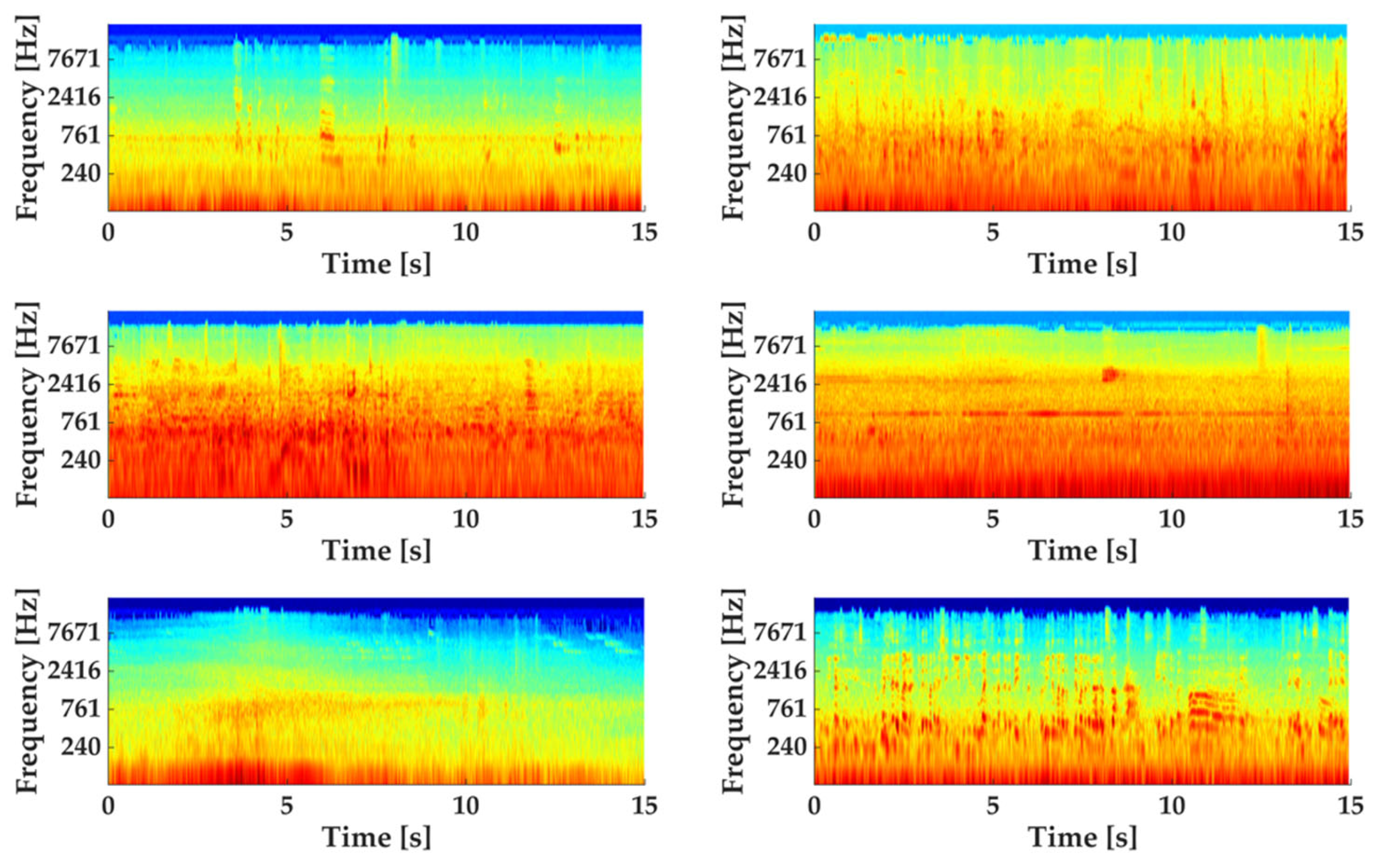
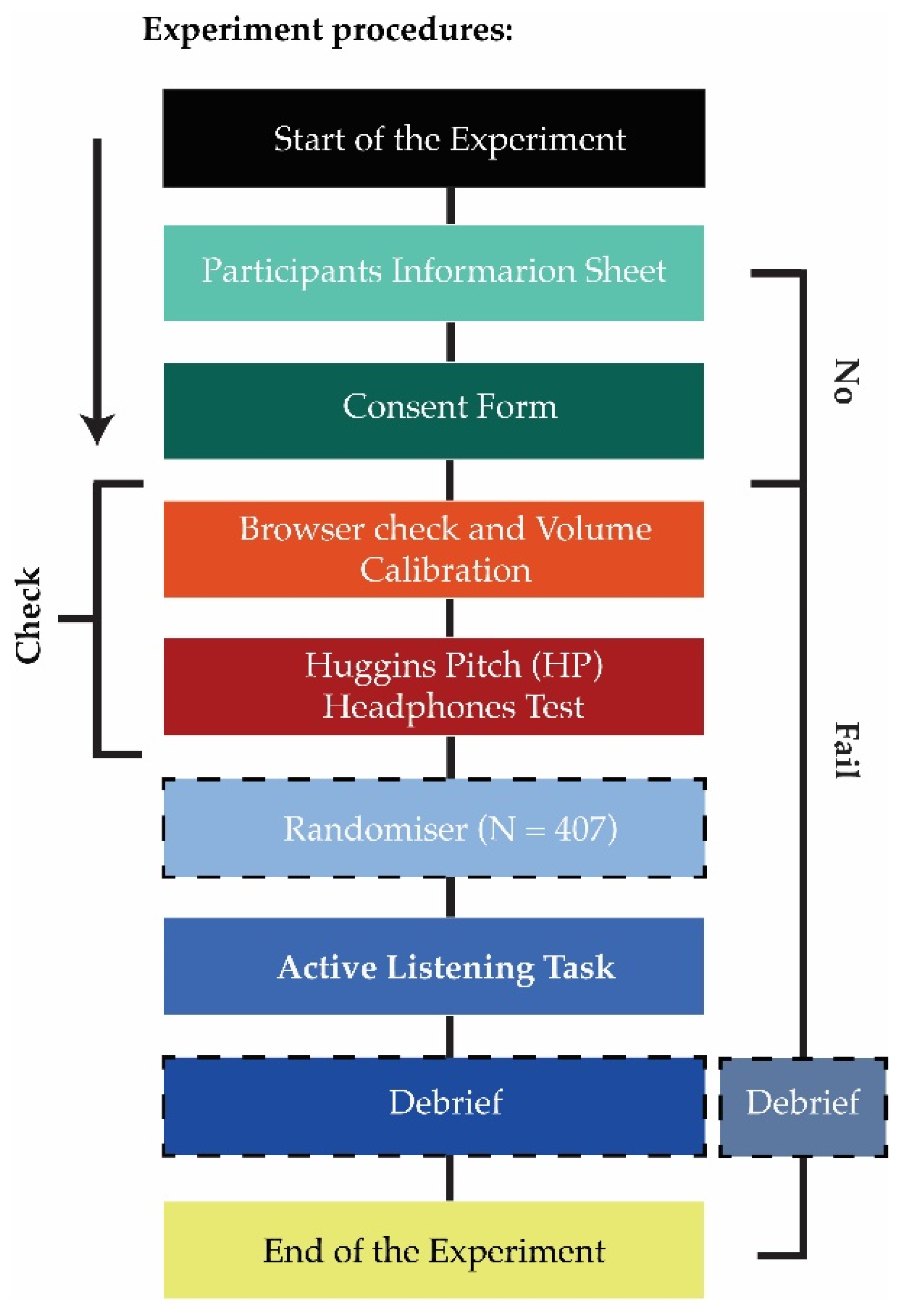
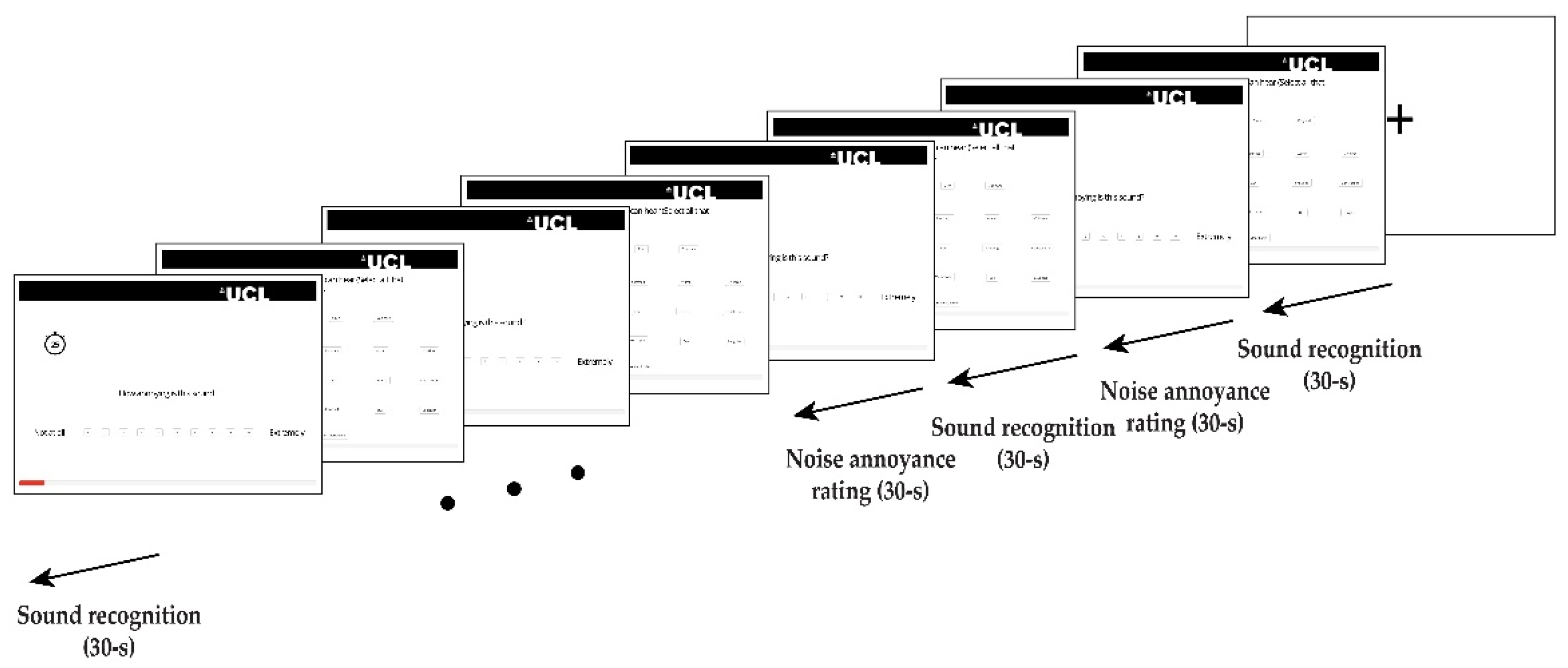
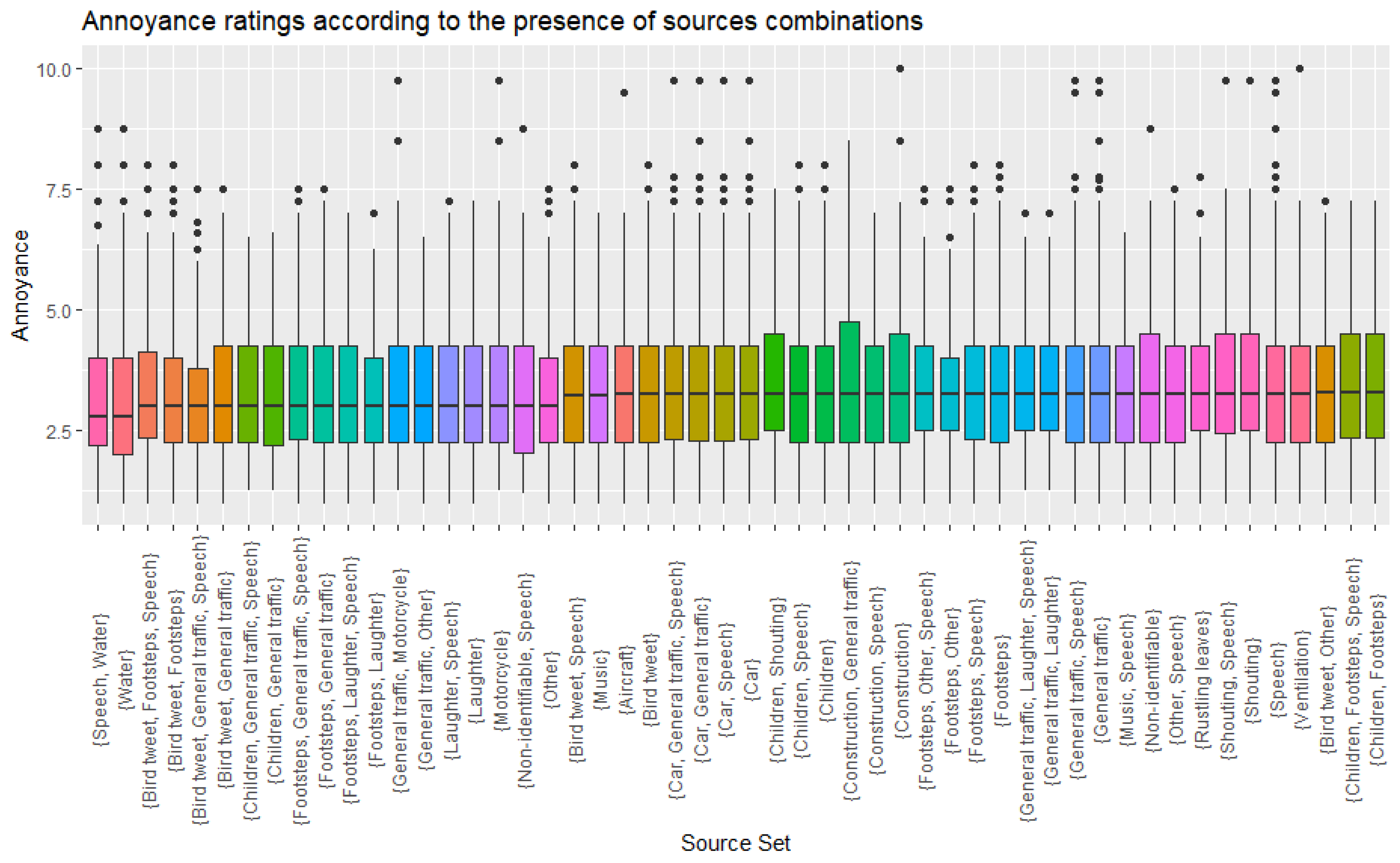
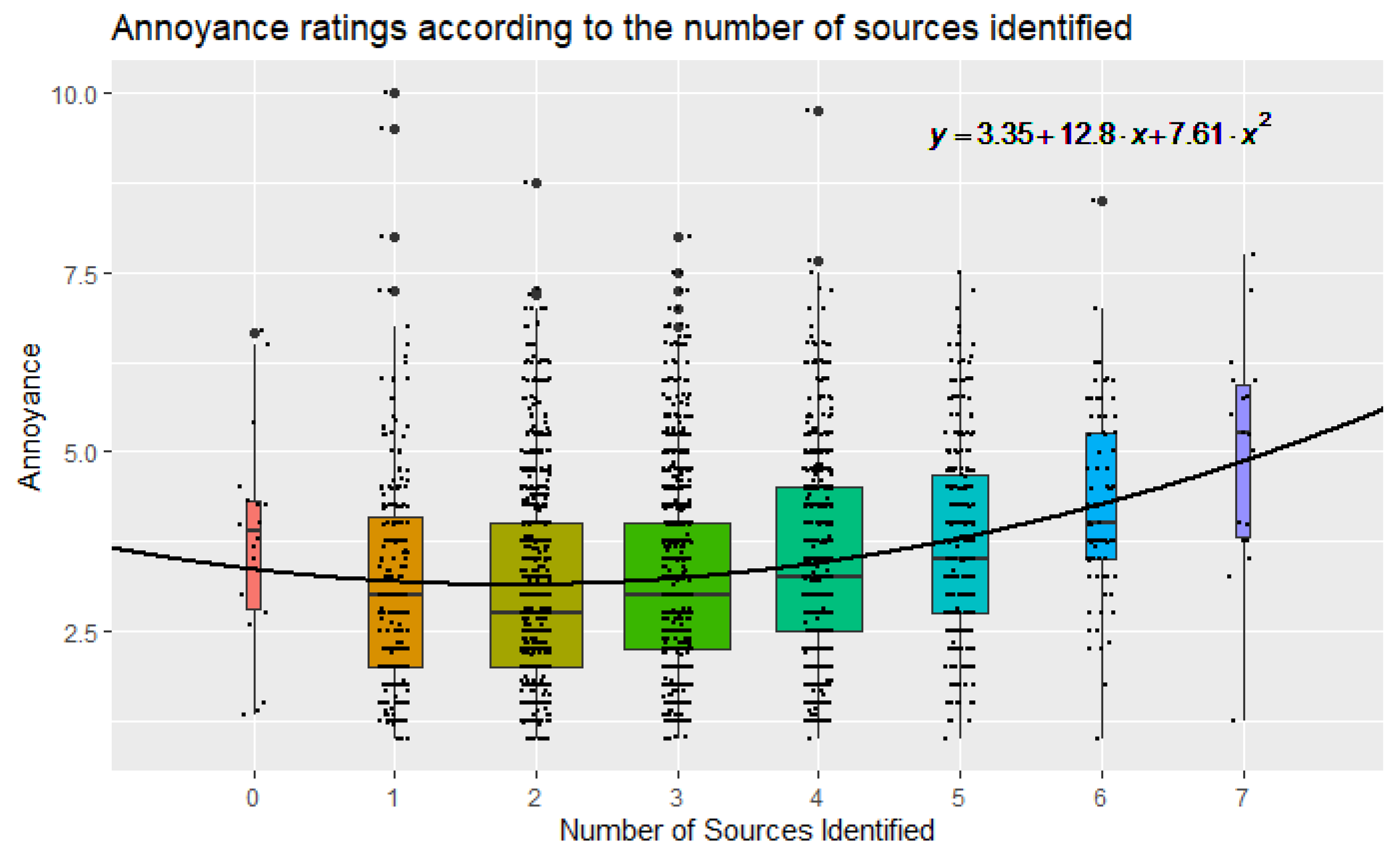
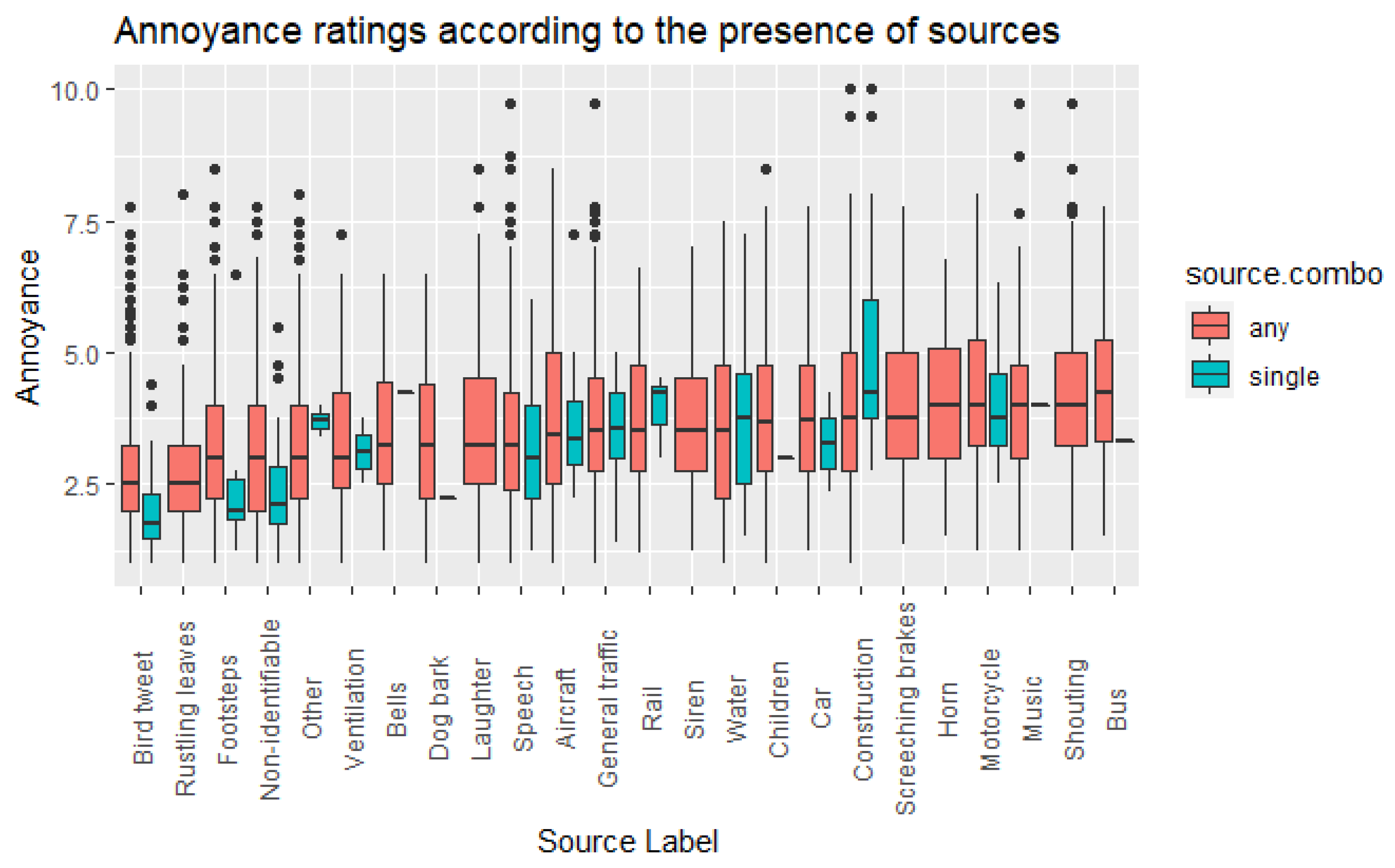
| Annoyance Scores | t-Test for Equality of Means | ||||||||
|---|---|---|---|---|---|---|---|---|---|
| Source | Present | N | Mean | Std. Deviation | Std. Error Mean | t | df | Sig. | Mean Difference |
| (2-Tailed) | |||||||||
| Aircraft | Yes | 118 | 3.71 | 1.61 | 0.15 | 2.533 | 124.41 | 0.013 | 0.38 |
| No | 2772 | 3.33 | 1.38 | 0.03 | |||||
| Bells | Yes | 54 | 3.44 | 1.20 | 0.16 | 0.489 | 2888.00 | 0.625 1 | 0.09 |
| No | 2836 | 3.35 | 1.40 | 0.03 | |||||
| Bird tweet | Yes | 932 | 2.71 | 1.16 | 0.04 | −19.034 | 2168.24 | 0.000 | −0.94 |
| No | 1958 | 3.65 | 1.39 | 0.03 | |||||
| Bus | Yes | 83 | 4.31 | 1.42 | 0.16 | 6.423 | 2888.00 | 0.000 | 0.99 |
| No | 2807 | 3.32 | 1.38 | 0.03 | |||||
| Car | Yes | 330 | 3.73 | 1.35 | 0.07 | 5.318 | 2888.00 | 0.000 | 0.43 |
| No | 2560 | 3.30 | 1.39 | 0.03 | |||||
| Children | Yes | 356 | 3.78 | 1.41 | 0.07 | 6.254 | 2888.00 | 0.000 | 0.49 |
| No | 2534 | 3.29 | 1.38 | 0.03 | |||||
| Construction | Yes | 270 | 4.02 | 1.57 | 0.10 | 7.528 | 311.48 | 0.000 | 0.75 |
| No | 2620 | 3.28 | 1.35 | 0.03 | |||||
| Dog bark | Yes | 33 | 3.34 | 1.35 | 0.24 | −0.016 | 2888.00 | 0.987 1 | 0.00 |
| No | 2857 | 3.35 | 1.39 | 0.03 | |||||
| Footsteps | Yes | 1118 | 3.18 | 1.26 | 0.04 | −5.221 | 2620.68 | 0.000 | −0.27 |
| No | 1772 | 3.45 | 1.46 | 0.03 | |||||
| General traffic | Yes | 1166 | 3.63 | 1.34 | 0.04 | 9.037 | 2888.00 | 0.000 | 0.47 |
| No | 1724 | 3.16 | 1.40 | 0.03 | |||||
| Horn | Yes | 76 | 3.94 | 1.36 | 0.16 | 3.802 | 2888.00 | 0.000 | 0.61 |
| No | 2814 | 3.33 | 1.39 | 0.03 | |||||
| Laughter | Yes | 358 | 3.56 | 1.37 | 0.07 | 3.109 | 2888.00 | 0.002 | 0.24 |
| No | 2532 | 3.32 | 1.39 | 0.03 | |||||
| Motorcycle | Yes | 169 | 4.17 | 1.41 | 0.11 | 8.028 | 2888.00 | 0.000 | 0.88 |
| No | 2721 | 3.30 | 1.38 | 0.03 | |||||
| Music | Yes | 222 | 4.01 | 1.33 | 0.09 | 7.437 | 2888.00 | 0.000 | 0.72 |
| No | 2668 | 3.29 | 1.38 | 0.03 | |||||
| Non-identifiable | Yes | 251 | 3.11 | 1.43 | 0.09 | −2.818 | 2888.00 | 0.005 | −0.26 |
| No | 2639 | 3.37 | 1.39 | 0.03 | |||||
| Other | Yes | 391 | 3.21 | 1.29 | 0.07 | −2.256 | 544.31 | 0.024 | −0.16 |
| No | 2499 | 3.37 | 1.41 | 0.03 | |||||
| Rail | Yes | 77 | 3.70 | 1.26 | 0.14 | 2.237 | 2888.00 | 0.025 | 0.36 |
| No | 2813 | 3.34 | 1.39 | 0.03 | |||||
| Rustling leaves | Yes | 106 | 2.85 | 1.40 | 0.14 | −3.749 | 2888.00 | 0.000 | −0.52 |
| No | 2784 | 3.37 | 1.39 | 0.03 | |||||
| Screeching brakes | Yes | 52 | 3.98 | 1.32 | 0.18 | 3.295 | 2888.00 | 0.001 | 0.64 |
| No | 2838 | 3.34 | 1.39 | 0.03 | |||||
| Shouting | Yes | 199 | 4.21 | 1.45 | 0.10 | 9.139 | 2888.00 | 0.000 | 0.92 |
| No | 2691 | 3.28 | 1.37 | 0.03 | |||||
| Siren | Yes | 95 | 3.72 | 1.38 | 0.14 | 2.661 | 2888.00 | 0.008 | 0.39 |
| No | 2795 | 3.33 | 1.39 | 0.03 | |||||
| Speech | Yes | 1949 | 3.43 | 1.35 | 0.03 | 4.431 | 1741.72 | 0.000 | 0.25 |
| No | 941 | 3.18 | 1.46 | 0.05 | |||||
| Ventilation | Yes | 146 | 3.32 | 1.31 | 0.11 | −0.265 | 2888.00 | 0.791 1 | −0.03 |
| No | 2744 | 3.35 | 1.40 | 0.03 | |||||
| Water | Yes | 344 | 3.51 | 1.53 | 0.08 | 2.190 | 421.05 | 0.029 | 0.19 |
| No | 2546 | 3.32 | 1.37 | 0.03 | |||||
Publisher’s Note: MDPI stays neutral with regard to jurisdictional claims in published maps and institutional affiliations. |
© 2022 by the authors. Licensee MDPI, Basel, Switzerland. This article is an open access article distributed under the terms and conditions of the Creative Commons Attribution (CC BY) license (https://creativecommons.org/licenses/by/4.0/).
Share and Cite
Mitchell, A.; Erfanian, M.; Soelistyo, C.; Oberman, T.; Kang, J.; Aldridge, R.; Xue, J.-H.; Aletta, F. Effects of Soundscape Complexity on Urban Noise Annoyance Ratings: A Large-Scale Online Listening Experiment. Int. J. Environ. Res. Public Health 2022, 19, 14872. https://doi.org/10.3390/ijerph192214872
Mitchell A, Erfanian M, Soelistyo C, Oberman T, Kang J, Aldridge R, Xue J-H, Aletta F. Effects of Soundscape Complexity on Urban Noise Annoyance Ratings: A Large-Scale Online Listening Experiment. International Journal of Environmental Research and Public Health. 2022; 19(22):14872. https://doi.org/10.3390/ijerph192214872
Chicago/Turabian StyleMitchell, Andrew, Mercede Erfanian, Christopher Soelistyo, Tin Oberman, Jian Kang, Robert Aldridge, Jing-Hao Xue, and Francesco Aletta. 2022. "Effects of Soundscape Complexity on Urban Noise Annoyance Ratings: A Large-Scale Online Listening Experiment" International Journal of Environmental Research and Public Health 19, no. 22: 14872. https://doi.org/10.3390/ijerph192214872
APA StyleMitchell, A., Erfanian, M., Soelistyo, C., Oberman, T., Kang, J., Aldridge, R., Xue, J.-H., & Aletta, F. (2022). Effects of Soundscape Complexity on Urban Noise Annoyance Ratings: A Large-Scale Online Listening Experiment. International Journal of Environmental Research and Public Health, 19(22), 14872. https://doi.org/10.3390/ijerph192214872











